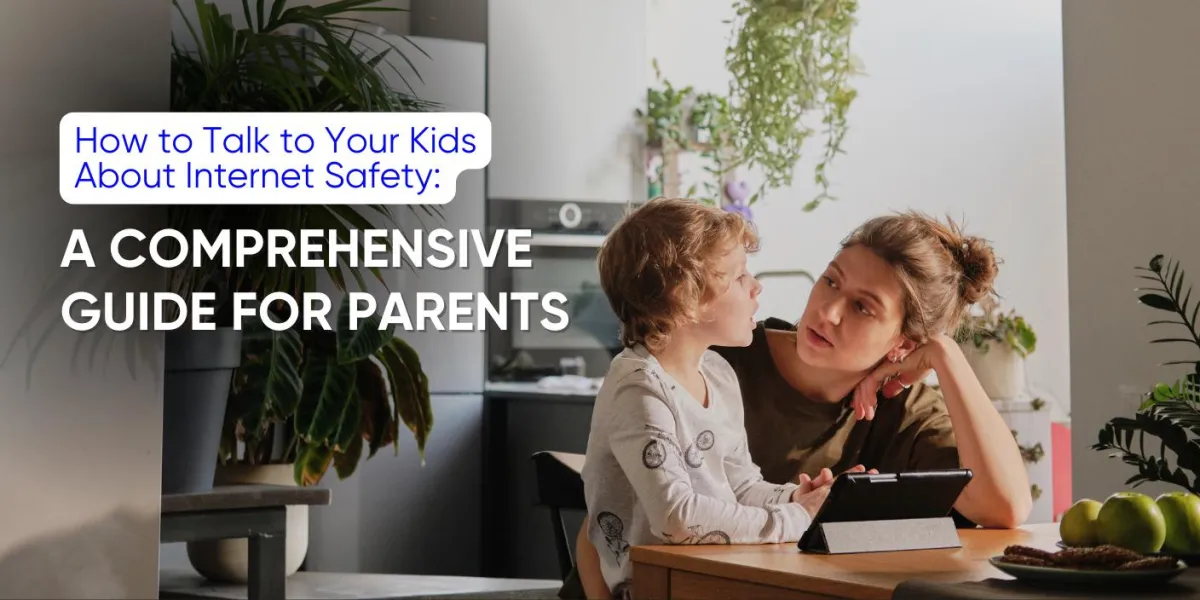You are what you click!
Learn how to make cybersecurity your way of life in an easy and guided way.
You are what you click!
Become Cyber savvy
EXPLORE BLOG BELOW
You are what you click!
Become Cyber savvy
You are what you click!
Become Cyber savvy
You are what you click!
Become Cyber savvy

How to Talk to Your Kids About Internet Safety: A Comprehensive Guide for Parents
How to Talk to Your Kids About Internet Safety: A Comprehensive Guide for Parents
In an era where digital devices are as commonplace as pencils and paper, parents face the daunting task of navigating the complex landscape of internet safety with their children. The online world offers endless opportunities for learning, creativity, and connection, but it also harbors risks that can seem overwhelming to both parents and kids alike. This comprehensive guide aims to equip parents with the knowledge and strategies needed to initiate and maintain open, age-appropriate conversations about internet safety, fostering a sense of digital citizenship that will serve children well into adulthood.
Understanding the Digital Landscape
Before diving into specific conversation strategies, it's crucial for parents to grasp the ever-changing nature of the digital world their children inhabit. From social media platforms to online gaming communities, the internet is a vast space that can be both enriching and potentially harmful. Recent studies indicate that children are accessing the internet at increasingly younger ages, with some reports suggesting that the average age of first internet use is now as low as 5 years old. This early exposure underscores the importance of proactive parental guidance in shaping healthy online behaviors from the outset.
Moreover, the pandemic accelerated the integration of technology into children's daily lives, with remote learning and increased screen time becoming the norm for many families. This shift has blurred the lines between online and offline experiences, making it more critical than ever for parents to be actively involved in their children's digital lives.
Age-Specific Tips for Internet Safety Conversations
Preschool and Early Elementary (Ages 3-7)
For the youngest internet users, safety conversations should focus on basic concepts and be woven into everyday activities. At this age, children are naturally curious and eager to learn, but their understanding of abstract concepts like privacy and online identity is limited. Parents should:
Use simple, concrete language to explain internet safety rules.
Implement parental controls and safe search settings on devices.
Actively participate in their child's online activities.
Introduce the concept of "digital strangers" and the importance of not sharing personal information.
A practical approach might involve creating a family "internet rulebook" with colorful illustrations, making the learning process engaging and memorable. For instance, a rule like "Always ask a grown-up before clicking on anything new" can be accompanied by a drawing of a child and adult looking at a computer screen together.
Middle Elementary to Tweens (Ages 8-12)
As children enter their tween years, their online independence typically grows, making this a critical period for reinforcing safety habits. Conversations at this stage should:
Address the permanence of online actions and the concept of digital footprints.
Discuss responsible social media use, even if children aren't yet using these platforms.
Explore the importance of strong passwords and basic cybersecurity practices.
Encourage critical thinking about online information and content.
Parents might consider implementing a "tech contract" with their children, outlining agreed-upon rules and consequences for internet use. This approach not only sets clear expectations but also involves the child in the process of establishing boundaries, fostering a sense of responsibility and ownership over their online behavior.
Teenagers (Ages 13-17)
For teenagers, internet safety conversations should evolve into more nuanced discussions about digital citizenship, online reputation, and the potential long-term consequences of online actions. Key topics to cover include:
The risks and responsibilities associated with social media presence.
Understanding and managing privacy settings across various platforms.
Recognizing and responding to cyberbullying, both as a potential victim and bystander.
The importance of maintaining a balance between online and offline activities.
The legal implications of certain online behaviors, such as sexting or sharing copyrighted material.
At this age, it's crucial to approach these conversations with respect for the teenager's increasing autonomy while still providing guidance. Parents might share relevant news stories or personal experiences to illustrate the real-world impact of online actions, encouraging thoughtful reflection rather than lecturing.

Conversation Starters: Breaking the Ice on Internet Safety
Initiating conversations about internet safety can feel awkward or forced, especially with older children who may perceive such discussions as an invasion of privacy. Here are some effective strategies to naturally introduce the topic:
Leverage current events: Use news stories about data breaches, viral trends, or cyberbullying incidents as springboards for discussion. For example, "Did you hear about the recent TikTok challenge that's causing concern? What are your thoughts on it?"
Share personal experiences: Open up about your own online encounters or challenges. This vulnerability can encourage children to reciprocate and share their experiences.
Ask for their expertise: Engage children by asking them to explain new apps or online trends. This approach acknowledges their knowledge and opens the door for discussions about safety features or potential risks.
Use hypothetical scenarios: Present "what if" situations to explore how they would handle various online challenges. For instance, "What would you do if a stranger asked to meet up with you after chatting online?"
Integrate discussions into daily routines: Make internet safety a regular topic during family dinners or car rides, normalizing these conversations as part of everyday life.

Key Safety Points to Cover: A Comprehensive Checklist
While the depth and complexity of internet safety discussions will vary by age, there are fundamental principles that should be consistently reinforced. This comprehensive checklist ensures that no crucial aspect of online safety is overlooked:
Personal Information Protection: Emphasize the importance of safeguarding personal details such as full name, address, phone number, and school information. Teach children to consult with a trusted adult before sharing any personal data online.
Strong Password Practices: Instruct on creating and maintaining robust, unique passwords for different accounts. Consider introducing the concept of password managers for older children and teenagers.
Recognizing Online Scams and Phishing: Educate children about common online scams, suspicious links, and the tactics used by cybercriminals to obtain sensitive information.
Social Media Awareness: Discuss the implications of oversharing on social platforms, the concept of digital footprints, and strategies for managing online reputation.
Cyberbullying Prevention and Response: Provide clear guidelines on identifying, reporting, and responding to cyberbullying incidents, both as a potential target and as a bystander.
Critical Evaluation of Online Content: Teach children to question the credibility of online information, recognize bias, and verify sources before accepting information as fact.
Safe Online Communication: Establish rules for interacting with others online, including the potential risks of communicating with strangers and the importance of maintaining offline relationships.
Digital Citizenship: Foster an understanding of responsible online behavior, including respect for others' privacy, intellectual property rights, and the impact of one's digital actions on the broader community.
Screen Time Management: Encourage a balanced approach to technology use, emphasizing the importance of offline activities and face-to-face interactions.
Online Gaming Safety: Address specific risks associated with online gaming, such as in-game purchases, communication with other players, and age-appropriate content selection.
Implementing Ongoing Internet Safety Education
Effective internet safety education is not a one-time conversation but an ongoing process that evolves as children grow and technology changes. Parents should aim to create an environment where open dialogue about online experiences is the norm, rather than the exception. This can be achieved through:
Regular check-ins: Set aside time each week to discuss recent online activities, challenges, or questions.
Family tech agreements: Collaboratively develop and periodically review guidelines for internet use that apply to all family members, including parents.
Leading by example: Demonstrate responsible online behavior and openly discuss your own digital habits and decision-making processes.
Utilizing educational resources: Take advantage of online safety courses, workshops, or webinars designed for families to learn together.
Staying informed: Keep abreast of new technologies, apps, and online trends to remain a relevant and knowledgeable resource for your children.
Conclusion: Empowering Digital Citizens
In navigating the complex terrain of internet safety with children, parents play a pivotal role in shaping the next generation of digital citizens. By fostering open communication, providing age-appropriate guidance, and consistently reinforcing key safety principles, parents can empower their children to harness the benefits of the digital world while mitigating its risks.
The journey of internet safety education is ongoing and dynamic, requiring patience, adaptability, and a commitment to continuous learning on the part of both parents and children. As we move forward in an increasingly interconnected world, the skills and awareness developed through these conversations will serve not just as protective measures, but as foundational elements of digital literacy and responsible online engagement.
By approaching internet safety as a collaborative family endeavor rather than a set of imposed restrictions, parents can help cultivate a generation of thoughtful, resilient, and savvy digital natives equipped to navigate the challenges and opportunities of the online world with confidence and integrity.
Live Happily Ever Cyber!

Sandra Estok
Subscribe for more ways to protect what matters most to you against hackers, scammers, and Cybermonsters™
Latest blog posts:

How to Talk to Your Kids About Internet Safety: A Comprehensive Guide for Parents
How to Talk to Your Kids About Internet Safety: A Comprehensive Guide for Parents
In an era where digital devices are as commonplace as pencils and paper, parents face the daunting task of navigating the complex landscape of internet safety with their children. The online world offers endless opportunities for learning, creativity, and connection, but it also harbors risks that can seem overwhelming to both parents and kids alike. This comprehensive guide aims to equip parents with the knowledge and strategies needed to initiate and maintain open, age-appropriate conversations about internet safety, fostering a sense of digital citizenship that will serve children well into adulthood.
Understanding the Digital Landscape
Before diving into specific conversation strategies, it's crucial for parents to grasp the ever-changing nature of the digital world their children inhabit. From social media platforms to online gaming communities, the internet is a vast space that can be both enriching and potentially harmful. Recent studies indicate that children are accessing the internet at increasingly younger ages, with some reports suggesting that the average age of first internet use is now as low as 5 years old. This early exposure underscores the importance of proactive parental guidance in shaping healthy online behaviors from the outset.
Moreover, the pandemic accelerated the integration of technology into children's daily lives, with remote learning and increased screen time becoming the norm for many families. This shift has blurred the lines between online and offline experiences, making it more critical than ever for parents to be actively involved in their children's digital lives.
Age-Specific Tips for Internet Safety Conversations
Preschool and Early Elementary (Ages 3-7)
For the youngest internet users, safety conversations should focus on basic concepts and be woven into everyday activities. At this age, children are naturally curious and eager to learn, but their understanding of abstract concepts like privacy and online identity is limited. Parents should:
Use simple, concrete language to explain internet safety rules.
Implement parental controls and safe search settings on devices.
Actively participate in their child's online activities.
Introduce the concept of "digital strangers" and the importance of not sharing personal information.
A practical approach might involve creating a family "internet rulebook" with colorful illustrations, making the learning process engaging and memorable. For instance, a rule like "Always ask a grown-up before clicking on anything new" can be accompanied by a drawing of a child and adult looking at a computer screen together.
Middle Elementary to Tweens (Ages 8-12)
As children enter their tween years, their online independence typically grows, making this a critical period for reinforcing safety habits. Conversations at this stage should:
Address the permanence of online actions and the concept of digital footprints.
Discuss responsible social media use, even if children aren't yet using these platforms.
Explore the importance of strong passwords and basic cybersecurity practices.
Encourage critical thinking about online information and content.
Parents might consider implementing a "tech contract" with their children, outlining agreed-upon rules and consequences for internet use. This approach not only sets clear expectations but also involves the child in the process of establishing boundaries, fostering a sense of responsibility and ownership over their online behavior.
Teenagers (Ages 13-17)
For teenagers, internet safety conversations should evolve into more nuanced discussions about digital citizenship, online reputation, and the potential long-term consequences of online actions. Key topics to cover include:
The risks and responsibilities associated with social media presence.
Understanding and managing privacy settings across various platforms.
Recognizing and responding to cyberbullying, both as a potential victim and bystander.
The importance of maintaining a balance between online and offline activities.
The legal implications of certain online behaviors, such as sexting or sharing copyrighted material.
At this age, it's crucial to approach these conversations with respect for the teenager's increasing autonomy while still providing guidance. Parents might share relevant news stories or personal experiences to illustrate the real-world impact of online actions, encouraging thoughtful reflection rather than lecturing.

Conversation Starters: Breaking the Ice on Internet Safety
Initiating conversations about internet safety can feel awkward or forced, especially with older children who may perceive such discussions as an invasion of privacy. Here are some effective strategies to naturally introduce the topic:
Leverage current events: Use news stories about data breaches, viral trends, or cyberbullying incidents as springboards for discussion. For example, "Did you hear about the recent TikTok challenge that's causing concern? What are your thoughts on it?"
Share personal experiences: Open up about your own online encounters or challenges. This vulnerability can encourage children to reciprocate and share their experiences.
Ask for their expertise: Engage children by asking them to explain new apps or online trends. This approach acknowledges their knowledge and opens the door for discussions about safety features or potential risks.
Use hypothetical scenarios: Present "what if" situations to explore how they would handle various online challenges. For instance, "What would you do if a stranger asked to meet up with you after chatting online?"
Integrate discussions into daily routines: Make internet safety a regular topic during family dinners or car rides, normalizing these conversations as part of everyday life.

Key Safety Points to Cover: A Comprehensive Checklist
While the depth and complexity of internet safety discussions will vary by age, there are fundamental principles that should be consistently reinforced. This comprehensive checklist ensures that no crucial aspect of online safety is overlooked:
Personal Information Protection: Emphasize the importance of safeguarding personal details such as full name, address, phone number, and school information. Teach children to consult with a trusted adult before sharing any personal data online.
Strong Password Practices: Instruct on creating and maintaining robust, unique passwords for different accounts. Consider introducing the concept of password managers for older children and teenagers.
Recognizing Online Scams and Phishing: Educate children about common online scams, suspicious links, and the tactics used by cybercriminals to obtain sensitive information.
Social Media Awareness: Discuss the implications of oversharing on social platforms, the concept of digital footprints, and strategies for managing online reputation.
Cyberbullying Prevention and Response: Provide clear guidelines on identifying, reporting, and responding to cyberbullying incidents, both as a potential target and as a bystander.
Critical Evaluation of Online Content: Teach children to question the credibility of online information, recognize bias, and verify sources before accepting information as fact.
Safe Online Communication: Establish rules for interacting with others online, including the potential risks of communicating with strangers and the importance of maintaining offline relationships.
Digital Citizenship: Foster an understanding of responsible online behavior, including respect for others' privacy, intellectual property rights, and the impact of one's digital actions on the broader community.
Screen Time Management: Encourage a balanced approach to technology use, emphasizing the importance of offline activities and face-to-face interactions.
Online Gaming Safety: Address specific risks associated with online gaming, such as in-game purchases, communication with other players, and age-appropriate content selection.
Implementing Ongoing Internet Safety Education
Effective internet safety education is not a one-time conversation but an ongoing process that evolves as children grow and technology changes. Parents should aim to create an environment where open dialogue about online experiences is the norm, rather than the exception. This can be achieved through:
Regular check-ins: Set aside time each week to discuss recent online activities, challenges, or questions.
Family tech agreements: Collaboratively develop and periodically review guidelines for internet use that apply to all family members, including parents.
Leading by example: Demonstrate responsible online behavior and openly discuss your own digital habits and decision-making processes.
Utilizing educational resources: Take advantage of online safety courses, workshops, or webinars designed for families to learn together.
Staying informed: Keep abreast of new technologies, apps, and online trends to remain a relevant and knowledgeable resource for your children.
Conclusion: Empowering Digital Citizens
In navigating the complex terrain of internet safety with children, parents play a pivotal role in shaping the next generation of digital citizens. By fostering open communication, providing age-appropriate guidance, and consistently reinforcing key safety principles, parents can empower their children to harness the benefits of the digital world while mitigating its risks.
The journey of internet safety education is ongoing and dynamic, requiring patience, adaptability, and a commitment to continuous learning on the part of both parents and children. As we move forward in an increasingly interconnected world, the skills and awareness developed through these conversations will serve not just as protective measures, but as foundational elements of digital literacy and responsible online engagement.
By approaching internet safety as a collaborative family endeavor rather than a set of imposed restrictions, parents can help cultivate a generation of thoughtful, resilient, and savvy digital natives equipped to navigate the challenges and opportunities of the online world with confidence and integrity.
Live Happily Ever Cyber!

Sandra Estok
Subscribe for more ways to protect what matters most to you against hackers, scammers, and Cybermonsters™
Stop Hackers, Scammers and Cybermonsters in their tracks.
Take charge of your Cyber Life today!
Push Cybermonsters away from your private data.
Subscribe to my newsletter about cybersecurity and cyber safety. New issues every Tuesday.




